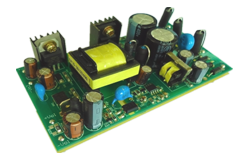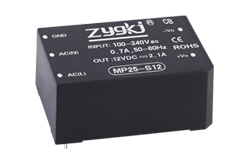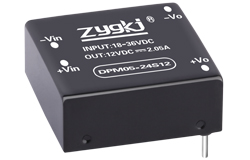nyheder
How to Build an AC-DC Converter
Author: ZYG Power Module Time: 2023-4-12
An AC-DC converter, also known as a rectifier, is an electrical device that converts alternating current (AC) power to direct current (DC) power. This conversion process is essential for many electronic devices, as they require DC power to function properly. In this article, we will discuss the basic principles of building an AC-DC converter.
The first step in building an AC-DC converter is to choose the right components. The most important components of an AC-DC converter are a transformer, a diode bridge, and a filter capacitor. The transformer is used to step down the AC voltage to a lower voltage that can be rectified. The diode bridge is used to rectify the AC voltage, which means that it converts the AC voltage to a DC voltage. The filter capacitor is used to smooth out the DC voltage.
Once you have chosen the components, the next step is to connect them. First, connect the primary winding of the transformer to the AC power source. The primary winding is the winding that is connected to the AC power source. Then, connect the secondary winding of the transformer to the diode bridge. The secondary winding is the winding that is connected to the load. The diode bridge should be connected to the secondary winding in such a way that the positive output of the bridge is connected to the positive terminal of the load, and the negative output of the bridge is connected to the negative terminal of the load.

The final step in building an AC-DC converter is to add a filter capacitor. The filter capacitor is connected across the load, in parallel with the diode bridge. This capacitor works to smooth out the DC voltage by storing charge during the peaks of the AC voltage and releasing it during the troughs of the AC voltage. This results in a steady DC voltage output.
It is important to note that the output voltage of the AC-DC converter depends on the transformer turns ratio. The turns ratio of the transformer determines the voltage that is stepped down from the AC source. Therefore, if you want a specific output voltage, you will need to choose a transformer with the appropriate turns ratio.
In conclusion, building an AC-DC converter is a relatively simple process that requires a few basic components and some knowledge of electrical circuits. By following the steps outlined in this article, you can build your own AC-DC converter and power your electronic devices with DC voltage.

Tidligere: Transforming AC to DC: The AC-DC Converter
relevant information
-
2023-10-13
High Voltage Power Supply Module: Amplifying Energy Efficiency and Output Performance
Introduction High voltage power supply modules are essential components in various industries, ranging from healthcare to telecommunications. These modules are responsible for providing the necessary voltage levels to operate various devices and equipment. With advancements in technology, there has been a growing demand for more efficient and high-performing power supply modules. This article aims to explore how high voltage power supply modules can amplify energy efficiency and output performance. Enhancing Energy Efficiency Energy efficiency is a crucial aspect when it comes to power supply modules. Inefficient power supplies not only waste energy but also generate excessive heat, leading to increased energy consumption and potential device failures. To amplify energy efficiency, high voltage power supply modules employ various techniques. One such...
Se detaljer -
2023-7-9
Bidirectional DC-DC Converter: A Solution for Efficient Energy Conversion
Introduction In recent years, the demand for efficient energy conversion has been on the rise due to the increasing use of renewable energy sources and the need for energy storage systems. One key component in achieving efficient energy conversion is the bidirectional DC-DC converter. This article aims to explore the benefits and applications of bidirectional DC-DC converters in various industries. What is a Bidirectional DC-DC Converter? A bidirectional DC-DC converter is an electronic device that allows for the conversion of electrical energy between two DC voltage levels in either direction. It enables power flow in both forward and reverse directions, making it suitable for applications that require energy storage, such as electric vehicles, renewable energy systems, and grid-connected systems. Benefits...
Se detaljer -
2023-5-27
AC DC Converter Module: What You Need to Know
An AC DC converter module is an essential component in many electronic devices. It is used to convert alternating current (AC) to direct current (DC), which is required for proper functioning of electronic circuits. In this article, we will discuss everything you need to know about AC DC converter modules, including their working principle, types, and applications. Working Principle of AC DC Converter Module The working principle of an AC DC converter module is based on the principle of rectification. The input AC signal is first converted into a pulsating DC signal using a rectifier circuit. The pulsating DC signal is then filtered using a capacitor, which removes any residual AC components and produces a stable DC output voltage. Types...
Se detaljer -
2023-7-23
Efficient AC to DC Converter for LED Lights: 12V Solution
Introduction LED lights have gained popularity in recent years due to their energy efficiency, long lifespan, and versatility in design. However, one of the challenges in using LED lights is converting the alternating current (AC) from the power grid into direct current (DC) required by the LED lights. In this article, we will explore an efficient AC to DC converter solution for LED lights, specifically focusing on a 12V system. Background LED lights operate on DC power, which is different from the AC power supply available in most households. Therefore, an AC to DC converter is needed to ensure the proper functioning of LED lights. The converter's primary function is to convert the AC voltage into a stable and regulated...
Se detaljer -
2023-6-24
Bi-Directional DC-DC Converter: Efficient Power Conversion in Both Directions
Introduction The development of renewable energy sources has led to the need for efficient power conversion technologies. One such technology is the bi-directional DC-DC converter, which is capable of converting power in both directions. This article discusses the operation and benefits of bi-directional DC-DC converters in power conversion systems. Bi-Directional DC-DC Converter Operation A bi-directional DC-DC converter is a power electronic device that can convert DC voltage from one level to another and transfer power in both directions. The converter consists of two power switches, an inductor, and a capacitor. The switches are controlled by a digital controller that determines the direction of power flow. The operation of the bi-directional DC-DC converter can be divided into two modes: the buck...
Se detaljer -
2023-8-9
Efficient AC to DC Converter manufacture: Powering LED Lights with a 12V Output
In recent years, LED lights have gained popularity due to their energy efficiency, long lifespan, and versatile applications. However, to power these lights, an efficient AC to DC converter is required. In this article, we will explore the importance of such a converter and how it enables us to power LED lights with a 12V output. An AC to DC converter, also known as a rectifier, is an electrical device that converts alternating current (AC) into direct current (DC). This conversion is necessary because most electronic devices, including LED lights, require DC power to function. AC power, which is supplied by the electrical grid, constantly changes direction, whereas DC power flows in a single direction. LED lights, unlike traditional incandescent...
Se detaljer


















